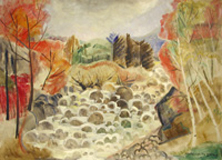Being Where Looking Into Landscape
Being Where Looking Into Landscape
Being Where: Looking Into Landscape presented a wide variety of approaches to the ideal associated with landscape. Through various mediums including painting, printmaking, and photography, the landscape was pictured, from 1860 to the present, as anywhere from a place to record and cherish, to a sublime ideal or even a place to be pitied. The exhibition included works by Eugene Atget, Emily Muir, Ralph Blakelock, Paul Caponigro, Stephen Etnier, John Marin, Frederick Childe Hassam, Marsden Hartley, Neil Welliver, Andrew Wyeth and Marguerite Zorach as well as many younger, contemporary artists.
Throughout history, art that deals with landscape has usually been two-dimensional and representational: paintings of fields, forests, or other types of scenery. The outcome of looking at a landscape painting, print, or photograph can often result in an episode of self-inflicted questioning. Much like the tenets of a journalist — the who, what, where, and how of the work — helps root the viewer “into” the landscape. Many of the works in this exhibition will pose this type of inquiry. Yet other questions may suddenly occur because with closer inspection all is not always what it seems. Works like George Inness’ The Elm and Beate Gütschow’s LS #14 share very similar strategies even though they were made in very different mediums over 135 years apart. They speak of the artist’s desire to create the perfect moment, the ideal landscape. Inness employed the same elm tree over and over again because it was representational and expedient, while painting not in the landscape itself but in the studio. Gütschow fabricates her arcadia through “stitching” multiple photographs of various landscapes together. In each case, the finished work is not a depiction of a specific place. It is a sense of place.
Being Where offerd a variety of landscapes that at times stretch the traditional definition of what we hope a landscape is or really looks like. Artists in this exhibition quietly expand the confines of what they observe before them. They strive to “re-see” the world through diverse strategies. The emphasis is often beyond the specific task of recording reality. The landscape may act as a metaphor of dreams, fantasy or simply the will to reinterpret beyond recognition.

Trout Stream, 1966
Oil on canvas
